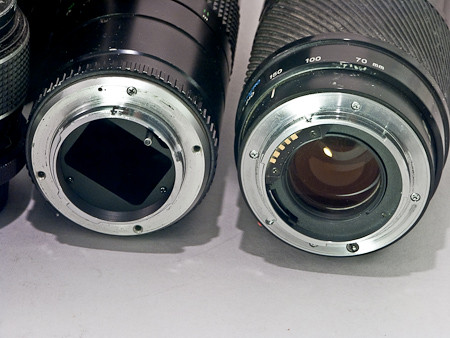
Telling tell A-Mount and Rokkor Lenses Apart
So you are strolling through a flea-market or garage sale and you stumble across a cache of old Minolta lenses. They look clean and the optics are clear. Will they fit your Sony Alpha?
If you read my earlier post on using Minolta lenses on the Sony Alpha, you know that only A-Mount Minolta lenses work on the Sony Alpha without using an adapter. So the question is, can you identify which Minolta lenses use the A-Mount?
Brand Name appears above front element
Although Minolta never used the term A-Mount on their lenses, most A-Mount lenses sold in the North American market carried the name Maxxum above the front element. Minolta used different trade names in other countries, so presumably A-mount lenses may have been marked differently on other continents. In today’s global environment, you may find that lenses from other countries have made their way to the US, and North American lenses could have wound up in other continents. So you cannot rely solely on the brand name to determine whether a Minolta lens is in fact, an A-mount lens.
Still, all lenses marked Maxxum are A-Mount optics.
Most of the older Minolta lenses are marked with the Rokkor name, but Minolta started selling SR lenses before the Rokkor brand emerged. As the Rokkor line was being phased out, Minolta stopped using that name on their lenses, so many Rokkor mount lenses are floating around with no identification. Minolta also marketed an inexpensive series of lenses under the Celtic brand name. These use the Rokkor style mount and are not A-Mount compatible.
Rokkor lenses have an Aperture Ring
Except for a few fixed-aperture lenses, all Rokkor lenses have a physical adjusting ring that controls the aperture opening. If you find a Minolta lens with an aperture ring, it is definitely a Rokkor style mount, not an A-Mount. Catadioptric (mirror) lenses do not have an adjustable aperture, and you may come across other specialty Rokkor lenses without an aperture ring. If a lens has a ring, however, it is not an A-Mount lens.
Electrical Contacts on A-Mount

Another clue to the lens type is found inside the mount itself. Rokkor lenses are fully mechanical and have no electrical contacts. A-mount lenses, on the other hand, use electrical contacts so the camera can control the aperture opening, auto-focusing and image stabilization. If you see contacts inside a Minolta mount it is not a Rokkor, and is either an A-Mount or Vectis style lens.
One minor caveat: just before releasing the first auto-focus Maxxums, Minolta experimented with focus-confirmation Rokkor lenses. These were only used on the rare X-600 bodies and only marketed in Japan. These lenses do not provide auto-focus, but when used on a X-600, the camera will indicate when the lens is properly focused. While quite rare, these Rokkor style lenses do have electrical contacts to communicate with the camera. I doubt you will come across one of these, but you can still tell them apart from A-Mount lenses, as the A-Mount optics have either five or seven contacts on the mount.
Diaphragm post on Rokkor
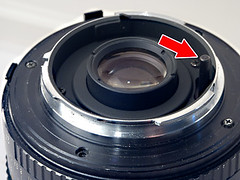
One last difference between the A-mount and the a Rokkor lenses is the mechanical automatic diaphragm mechanism. On the Rokkor optics, the auto-diaphragm is controlled by a cylindrical post that protrudes from the mount. On the A-mount optics the camera operates the auto-diaphragm through a recessed lever inside the mount. Some of the pre-Rokkor SR lenses did not have an automatic diaphragm, and these lenses do not have a control post. Overall, however, the auto diaphragm post is dead give-away that the lens in question is using a Rokkor style mount.
You should now be equipped to easily recognize the differences between the A-Mount and Rokkor lens line. You still need to watch out for Minolta Vectis lenses, however. These were created for the short-lived Vectis SLR Minolta created in the late 1990s. They look quite similar to the A-mount lenses, but they are NOT compatible. Avoid Vectis lenses if you are looking for glass to fit your Sony Alpha dSLR.
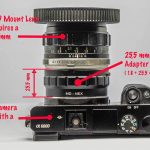
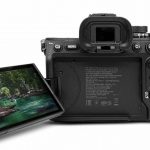
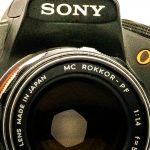


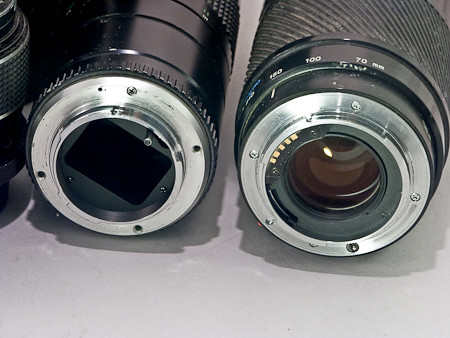

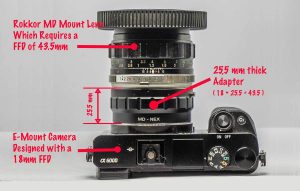



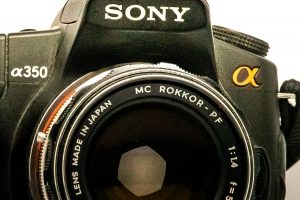
What adaptor do you use to use rokkor lenses on the Sony Alpha bodies?
Where can I get an adapter to use the Rokkor lens on my Sony a350
Hi Shirley,
Thanks for your question. MC (Rokkor) lens to Sony A-Mount adapters used to be rare and hard to come by, but today they are quite plentiful.
You will find two different kinds of Rokkor to Sony adapters. Some are marketed as “no-glass” or macro adapters, while others contain a lens or or “optical glass.”
Most users will need the adapter with optical glass. The no-glass adapters will allow you to shoot close-ups and macro shots, but the adapters without glass cannot focus to infinity. So if you want to shoot images beyond close-ups, avoid the no-glass adapters and purchase a more-expensive adapter with optical glass.
You can start on ebay, if you are comfortable buying from China or Hong Kong. I have had no trouble with these foreign dealers, but sometimes you have to wait to receive your items.
Try these eBay listings for dealers selling optical glass adapters:
http://www.ebay.com/sch/i.html?_odkw=MD+to+Sony+MA&_osacat=30059&_from=R40&_trksid=p2045573.m570.l1313&_nkw=MD+to+Sony+MA+with+glass&_sacat=30059
Closer to home, B&H Photo sells the General Brand Lens Adapter for Sony Alpha/Maxxum Body to Minolta MD. http://www.bhphotovideo.com/c/product/97536-REG/General_Brand_Maxxum_Body_to_Minolta.html
The description does not say it has an optical glass lens, but judging from the price, I assume it does. If you order from B&H make sure it contains a glass lens.
You will also find numerous MC to MA adapters on Amazon. Just make sure you look for a MC/MD adapter designed to fit the Sony Alpha A-mount (Not E-mount, unless you are using a NEX model camera.) Again, get an adapter with optical glass so you can focus at infinity:
http://www.amazon.com/s/ref=nb_sb_noss?url=search-alias%3Daps&field-keywords=minolta+md+to+sony+ma+adapter
I hope that helps. Remember that on your A350 you will have to shoot in the manual mode if you use and adapter.
Regards, Tom